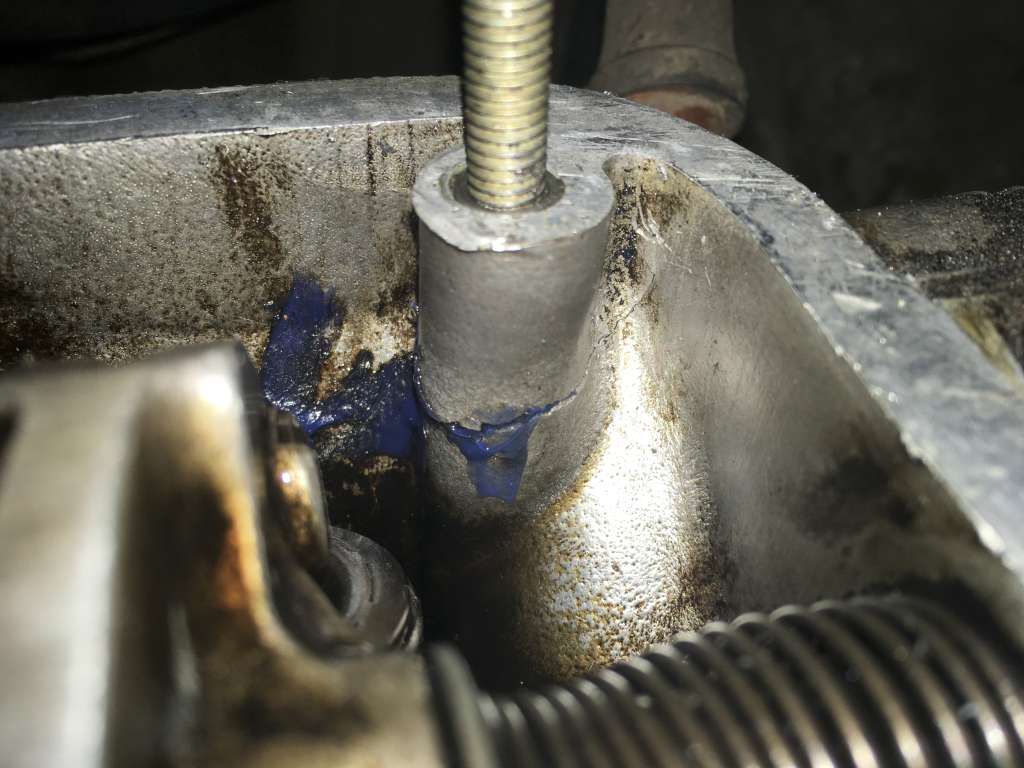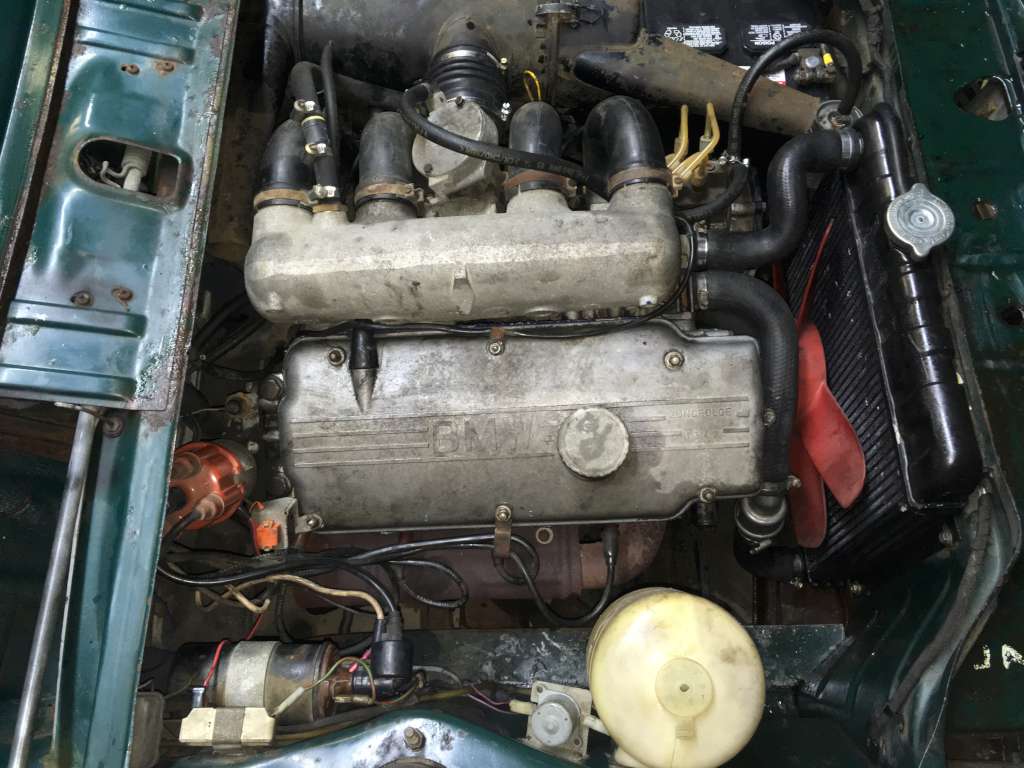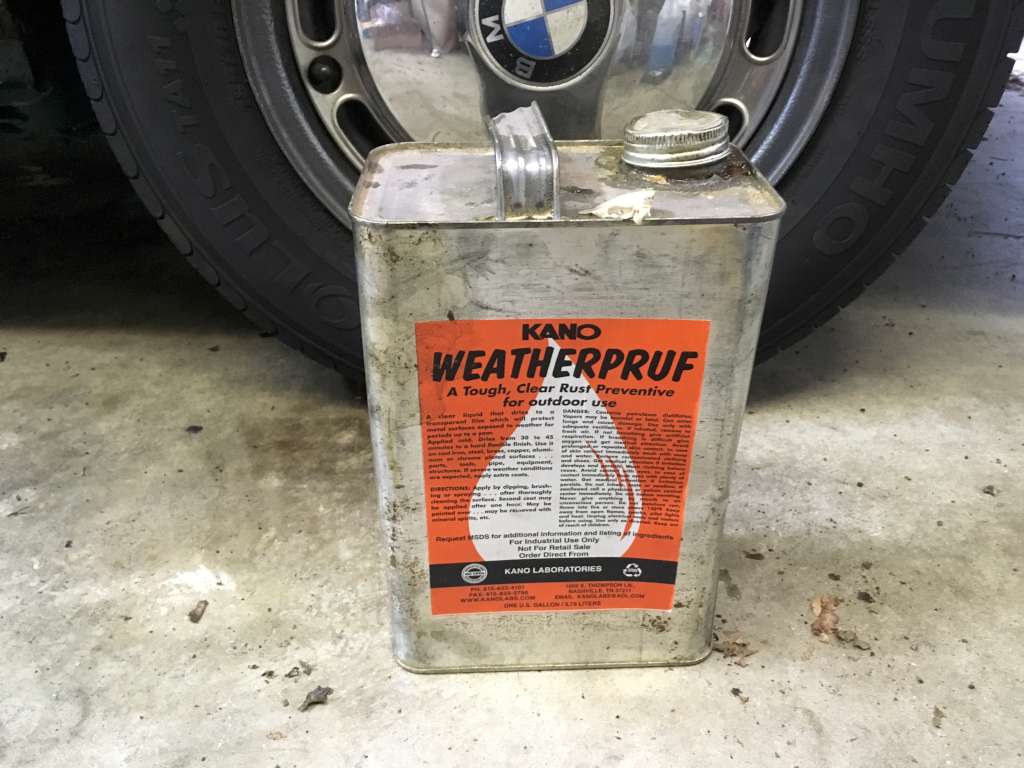Last week I described how I decided to adjust Louie’s valves prior to driving him down to the BMW CCA Foundation for inclusion into their upcoming 2002 exhibit. I explained how this was a bit of a pain, because last year when I resurrected Louie after his decade-long slumber, I couldn’t get the valve-cover gasket to stop dumping oil on the exhaust manifold. This turned out to be due to the threads holding in the lower left valve cover stud having been damaged. I’d sunk in a Time-Sert (helicoil) and a new stud, but oil still leaked at that corner; I finally sealed it up with black RTV.
Since adjusting the valves requires pulling up the valve cover, the gasket got shredded. I described how, in fact, this was a godsend, because while I was scraping the gasket pieces and black RTV off the upper timing cover, I found that the end plug of the intake rocker shaft had completely backed out and was dangling over the timing chain, threatening to grenade my engine. I explained how I fixed it by peening the plug back in place, then further ensured the engine’s safety by using a bracket that’s held in place by a head bolt and hangs over the end of the shaft.
You’d think I was out of the woods. I certainly did. But Louie’s head had another surprise in store for me.
After I’d put the end-plug adventure to bed, I was all set to button the head back up. I checked the valve-cover gasket surface one more time for stray black RTV. Then I noticed that there was a good-sized drip of blue RTV—not on the sealing surface, but down inside the head itself—evidence of the last time someone else had walked the path of trying to seal the leaky valve cover.
Since the car had been not only dead for ten years but largely inactive since 1980, the glob of blue RTV was probably several decades old. Sitting in that oily head, the odds of the glob detaching and sliding down inside the engine seemed substantial, so I began to clean it off. I couldn’t get a good shot at it from the right side of the engine, so I moved around to the left side.
And then, just as it had the moment I saw the rocker-shaft end plug threatening to jump into the timing chain, my jaw dropped. Standing at the other side of the engine, I could clearly see a big crack in the boss that held the repaired threads for the stud.

Uh-oh: a crack!
Suddenly it all made sense: This was why that corner of the valve cover gasket wouldn’t seal last year in Louisville, even after installing the Time-Sert. When I tightened the nut on the stud, I was probably just widening the crack.
Worse, the crack didn’t stop at the boss, but appeared to run off in the direction of the back upper corner of the head. In fact, it may be possible that someone had tried to seal up the crack itself with blue RTV, the implications of which I am still trying to wrap my, uh, head around. Yeesh!
Suddenly it seemed like Louie’s winter drive down to the Foundation was in serious jeopardy.
So I did what I do: I searched for options. I put out a feeler for what it would cost to ship Louie down to the Foundation. I asked if anyone had a spare 121ti head for a tii (46-mm intake valves, no fuel-pump hole). I posted a photo of the crack on Facebook and sought opinions.
Advice poured in. There were many comments from the “Just JB Weld it” camp, with some folks saying that it would be better if the boss was cracked clean off first, but others advising that I could use JB Weld to build up a reinforcing section on the outside of the boss. I thought that the odds of JB Weld being successful without thoroughly cleaning all the oil off the head (meaning removing it and tanking it) were slim, and pictured the adhesion failing and a big hard piece of JB Weld dropping down into the motor. No thanks.
There were numerous comments that the head could be TIG-welded, and probably easily so, since this wasn’t in the compression portion of the head and the repair didn’t need to look pretty—but with the same caution that the head would need to be scrupulously clean.
I have a good friend, Lindsey Brown, who is the shop foreman at The Little Foreign Car Garage in Waltham, Massachusetts. They tackle a whole variety of imported and domestic projects, from Mustangs to Rolls-Royces. Lindsey is an experienced and highly practical guy, so I drove over there to seek his advice. I don’t often do this during shop hours, but I figured that if I had a free spin card to use, now was the time.
I described the problem and showed Lindsey a photo of the crack. He pulled an old 2002 head down off the shelf so that he could better visualize things. He advised that, even the cleanliness and heat issues notwithstanding, it might be difficult for someone to weld the crack with the head on the car because the exhaust rocker shaft and #4 arm might be in the way.
Okay, so welding means the head has to come off. Got it.
I began to think what the logistical impact of that was. I was planning on leaving for South Carolina in a week to two weeks. On paper, that sounds like plenty of time to pull a head, disassemble it, tank it, get it welded, do the valves, rebuild it (hell, while I was in there, I could replace the rocker shaft with the wonky plug), and stick it back on. But I’d been down this road before with Kugel, my other ’72 tii. Six weeks before leaving for MidAmerica 02Fest a few years back, there were some sounds coming from the head I didn’t like, so I decided to pull it, figuring that at a minimum, it’d give me a chance to replace the original head gasket. It turned out that it had a bad rocker arm with a loose pad and a chunk missing.
But, just as important, one of the things I learned was that you shouldn’t pull a head off unless you’re prepared to deal with whatever you find. Some alarming-looking scuffing of the cylinder walls resulted in my pulling Kugel’s pistons and honing the block. I barely got the motor together in time to make 02Fest. On another tii I had, I pulled the head due to low compression in one cylinder. I thought I’d find a weak head gasket, but it turned out that the head was cracked in two places.
So pulling Louie’s head was a great idea, just not right now. Louie can have all the R&R time in the world—after he gets back from the Foundation in January 2019.
I asked Lindsey what other advice he had. He carefully scrutinized my photo of the crack, stuck a probe down the stud hole of the head he had at the shop, and estimated that it was likely that the threaded hole continued past the crack. He recommended that I verify this for myself on Louie’s head, and if necessary, run a tap down through the Time-Sert and try to bite into the threads beneath it, or tap new threads if there weren’t any. If there were threads below the crack, I could use an extra-long stud to try to sink into them, which should have the effect of pulling the two cracked sections together. He rooted around and found me an extra-long stud in case I didn’t have one, and tightened two 10-mm nuts together on it so that I could thread it in.
This struck me as a great idea.
Finally, Lindsey said that if the crack seemed stable, and if the biggest problem was what it was last year in Louisville—my simply wanting to stop oil from leaking onto the valve cover—he’d recommend using Permatex “The Right Stuff” adhesive, saying that this was what they use at the shop when they encounter leaky gaskets and are past the point of asking nicely. He cautioned, though, that it’d come off hard, like the black RTV I’d used before. I said that maybe I’d use the Permatex on the bottom valve-cover-gasket surface, but use non-drying Hylomar on the upper gasket surface so that if necessary I could still pull the cover off without shredding the gasket.
I profusely thanked Lindsey and the LFCG shop owners, Skipper and Julie, for Lindsey’s on-the-clock time, offered to pay for it, and was waved off. I drove straight to a nearby Autozone, and was delighted to find that they stocked the Right Stuff.
I got home, probed the hole in the boss with a pick, and thought that I felt threads below the crack, although it was hard to tell for sure. I ran a tap through the Time-Sert and into the section beneath the crack, but I didn’t like the way it felt; it felt like the tap was pushing back. The last thing I wanted to do was apply threaded leverage that might widen the crack. So I stopped.
The path forward seemed clear: Reassemble it. If it leaked, I had a problem, and if not, maybe I didn’t. I cleaned all the gasket surfaces one final time, laid a bead of the Right Stuff on the bottom of the gasket, set it in place, laid a bead of Hylomar on the top, put the cover on, and snugged it down, taking care to tighten the nut on the stud with the cracked boss perhaps only 1/3 as tight as the others.

“The Right Stuff” on the bottom, Hylomar on top
I then waited an hour, checked all the fluids, started the car, let it idle, and held my breath as I checked for oil seepage at that corner of the valve-cover gasket.
It was dry.
I backed the car out of the garage, did a quick skooch beneath the engine to look for oil and antifreeze leaks, and was alarmed by what appeared to be fresh antifreeze dripping from the bottom of the lower radiator hose. I checked all the hose clamps, didn’t find any that were loose, washed all the antifreeze off with the hose, let the car idle more, and rechecked. No more antifreeze. Huh. Must’ve been hanging around from when I swapped radiators.
I gingerly drove the car around the block, then rechecked everything. Still good.
One exit up and down the Mass Pike. Still good. More than good; the car ran great.
The next day, I used Louie for a whole bunch of errand-running. Not only did he return home leak-free, he felt the whole time like he was champing at the bit to get done with these preliminaries and run a thousand miles, just like he did the first time I took him out of Jake Metz’s pole barn in Louisville last year.
So, despite Louie punching back and nearly knocking me out, we appear to be ready to roll. My plan was to leave on Monday, February 19, exactly a year to the day after I headed south in the rented SUV loaded with tools and parts to resurrect Louie. Unfortunately, I will likely be deprived of such cosmic synchronicity, as snow appears to be moving into the Northeast. It’s likely that I’ll need to move the trip either forward or back a few days.
While Louie is not a rust-free car, and while I wouldn’t have the same sense that I’d be committing an act of violence against a vintage car if he was exposed to either a few fresh snowflakes or a bit of week-old powdery dry salt that I’d feel if I were driving the 3.0CSi, I was palpably aware that, if I found myself in the howling maw of winter weather and had to follow a conga line of snow plows and salt trucks to get to the nearest exit where there was a hotel, I would’ve clearly called it wrong.
Because of the possibility of weather, I did one more thing: I broke out the gallon of Kano Weatherpruf I’d bought a few years ago but had never used. This is from the folks who make SiliKroil. It’s basically like spreading motor oil, but stickier. I laid it with a brush on any surface rust I saw on the underbody of the car. Then, for good measure, I coated the insides of the front fenders and the fender wells with it.

Weatherproof, eh? Well, it can’t hurt.
Make no mistake, staying out of weather and moisture is better than any undercoating, and I intend to try—which is why, as I send this in, I am still uncertain when I’m leaving. We shall see what the next few days brings.—Rob Siegel
Got a question for Rob Siegel, the Hack Mechanic? You can find him in the BMW CCA Forums here!
Rob’s new book, Ran When Parked: How I Resurrected a Decade-Dead 1972 BMW 2002tii and Road-Tripped it a Thousand Miles Back Home, and How You Can, Too, is now available on Amazon. Or you can order personally inscribed copies through Rob’s website: www.robsiegel.com.





















